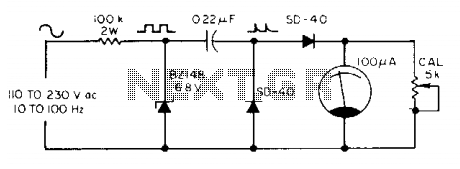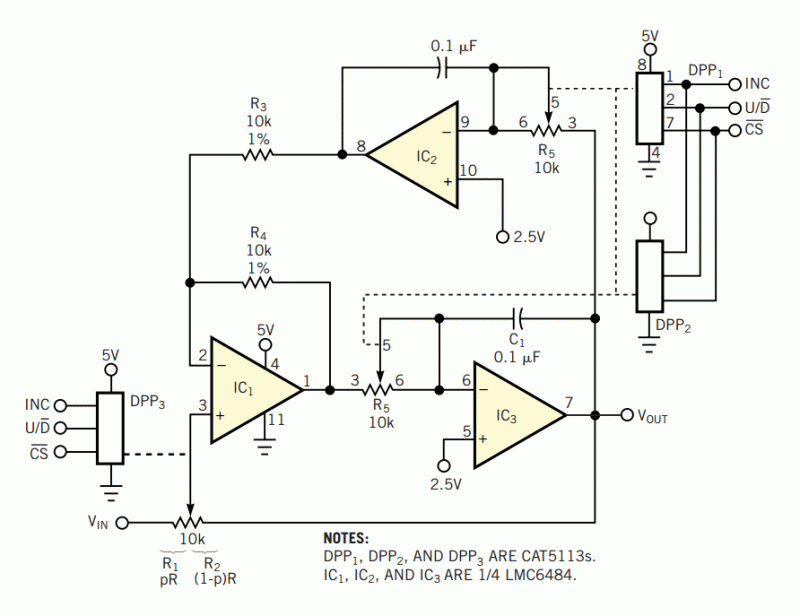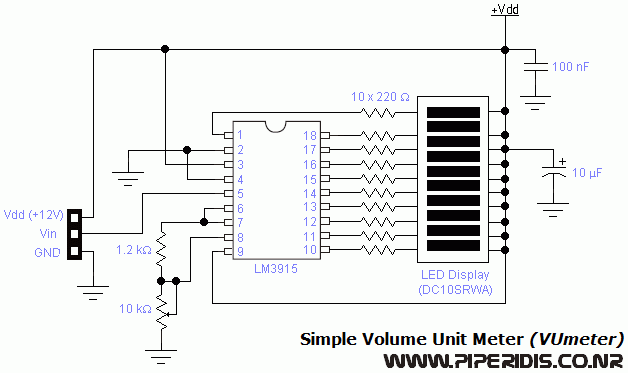
Contrast meter

One leg of the photocell (R1) is connected to the +15 volt supply, while the other end is linked to ground through resistor R2, creating a voltage-divider network. The non-inverting input of the 741 operational amplifier (IC1) is connected to the junction formed by R1 and R2, with its inverting input grounded through resistor R3. When switch S1 is activated, an additional voltage divider network is created, which reduces the voltage applied to the inverting input of the op-amp. When light strikes the photocell, its resistance decreases, leading to a larger voltage drop across R2 and a higher voltage at the non-inverting input of IC1. Consequently, IC1 produces an output voltage that is proportional to the two input voltages. The circuit provides a meter reading that varies with the intensity of light impacting photocell R1; therefore, R1 should be mounted in a bottle cap to ensure that light passes through a 3/16 inch hole. Potentiometer R5 is utilized to calibrate the circuit for the specific negative voltage in use.
The described circuit employs a photocell (R1) as a light sensor, effectively functioning as a variable resistor whose resistance decreases with increasing light intensity. The configuration of R1 and R2 forms a voltage divider that sets a reference voltage at the non-inverting input of the operational amplifier (IC1). The operational amplifier, a 741 type, is a general-purpose device capable of amplifying the difference between its two inputs. The inverting input is grounded through resistor R3, which establishes a stable reference point.
When switch S1 is pressed, it modifies the circuit by introducing another voltage divider, which adjusts the voltage at the inverting input. This additional divider can be utilized to set a threshold level for the light detection, allowing the op-amp to respond to specific light conditions. The output of the op-amp is influenced by the voltage levels at both inputs; as the light intensity increases, the voltage at the non-inverting input rises, leading to a higher output voltage from the op-amp.
The connection of the photocell in a bottle cap with a small aperture ensures that only a limited amount of light can reach the sensor, enhancing sensitivity and accuracy in measuring light intensity. The use of potentiometer R5 allows for fine-tuning of the circuit, accommodating variations in the power supply voltage or the specific characteristics of the photocell being used. This calibration is crucial for applications where precise light measurements are required. Overall, this circuit design provides a functional approach to light sensing and measurement, with potential applications in automatic lighting systems, light-level monitoring, and other photometric applications.One leg of the photocell (Rl) is tied to the +15 volt supply and the other end is connected to ground through resistor R2, forming a voltage-divider network. The non-inverting input of the 741 op amp, IC1, is tied to the junction formed by Rl and R2, while its inverting input is grounded through resistor R3.
When switch SI is pressed, another divider network is formed, reducing the voltage applied to the inverting input of the op amp. When light hits the photocell its resistance begins to decrease causing a greater voltage drop across R2 and a higher voltage to be presented to the non-inverting input of IC1.
This causes IC1 to output a voltage proportional to the two inputs. The circuit gives a meter reading that depends on the intensity of light hitting photocell Rl; therefore, Rl should be mounted in a bottle cap so that the light must pass through a 3/16 inch hole. Potentiometer R5 is used to adjust the circuit for the negative you're working with.
The described circuit employs a photocell (R1) as a light sensor, effectively functioning as a variable resistor whose resistance decreases with increasing light intensity. The configuration of R1 and R2 forms a voltage divider that sets a reference voltage at the non-inverting input of the operational amplifier (IC1). The operational amplifier, a 741 type, is a general-purpose device capable of amplifying the difference between its two inputs. The inverting input is grounded through resistor R3, which establishes a stable reference point.
When switch S1 is pressed, it modifies the circuit by introducing another voltage divider, which adjusts the voltage at the inverting input. This additional divider can be utilized to set a threshold level for the light detection, allowing the op-amp to respond to specific light conditions. The output of the op-amp is influenced by the voltage levels at both inputs; as the light intensity increases, the voltage at the non-inverting input rises, leading to a higher output voltage from the op-amp.
The connection of the photocell in a bottle cap with a small aperture ensures that only a limited amount of light can reach the sensor, enhancing sensitivity and accuracy in measuring light intensity. The use of potentiometer R5 allows for fine-tuning of the circuit, accommodating variations in the power supply voltage or the specific characteristics of the photocell being used. This calibration is crucial for applications where precise light measurements are required. Overall, this circuit design provides a functional approach to light sensing and measurement, with potential applications in automatic lighting systems, light-level monitoring, and other photometric applications.One leg of the photocell (Rl) is tied to the +15 volt supply and the other end is connected to ground through resistor R2, forming a voltage-divider network. The non-inverting input of the 741 op amp, IC1, is tied to the junction formed by Rl and R2, while its inverting input is grounded through resistor R3.
When switch SI is pressed, another divider network is formed, reducing the voltage applied to the inverting input of the op amp. When light hits the photocell its resistance begins to decrease causing a greater voltage drop across R2 and a higher voltage to be presented to the non-inverting input of IC1.
This causes IC1 to output a voltage proportional to the two inputs. The circuit gives a meter reading that depends on the intensity of light hitting photocell Rl; therefore, Rl should be mounted in a bottle cap so that the light must pass through a 3/16 inch hole. Potentiometer R5 is used to adjust the circuit for the negative you're working with.





